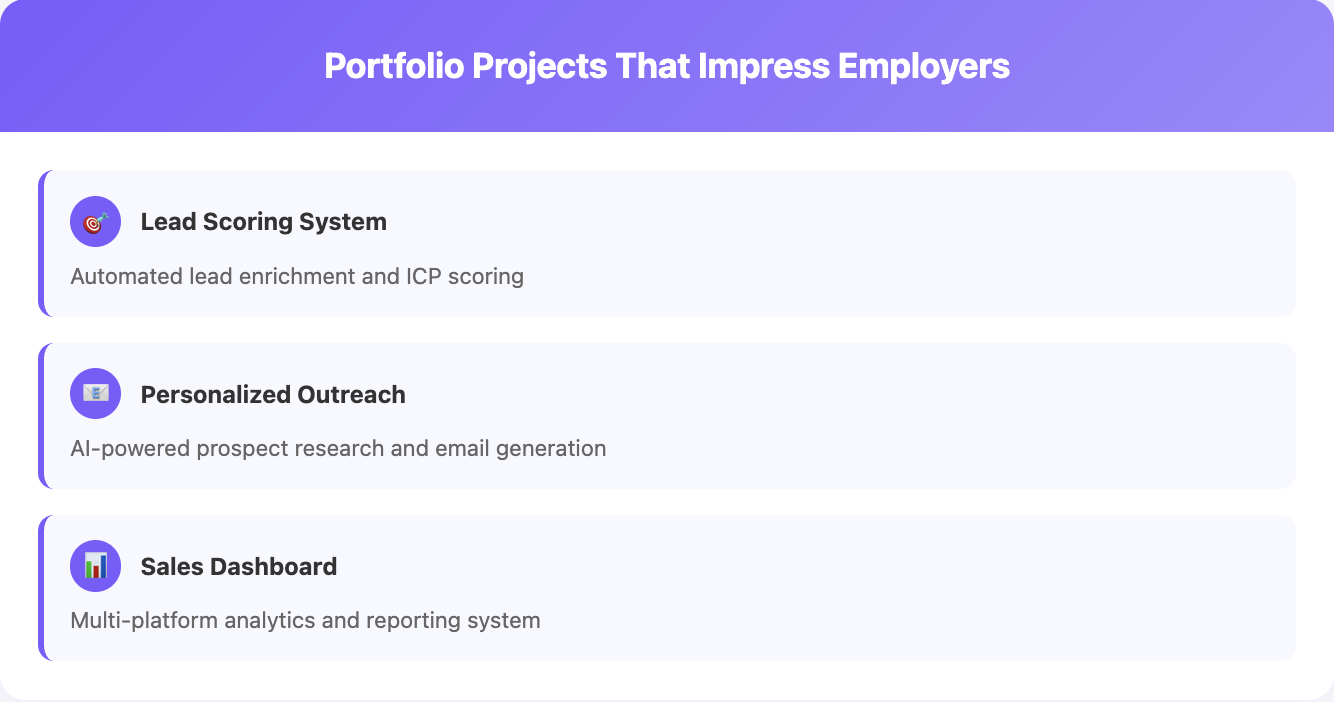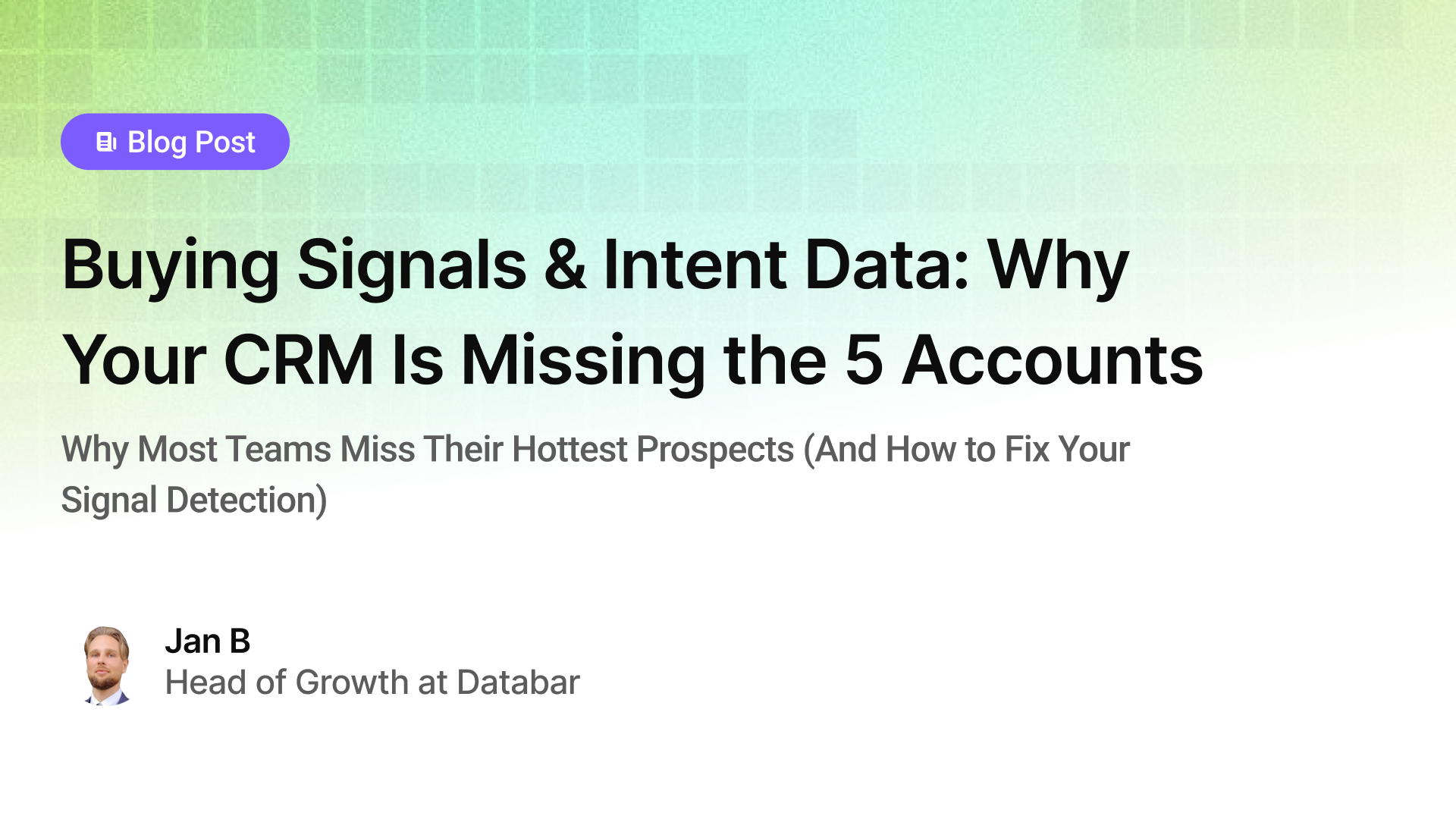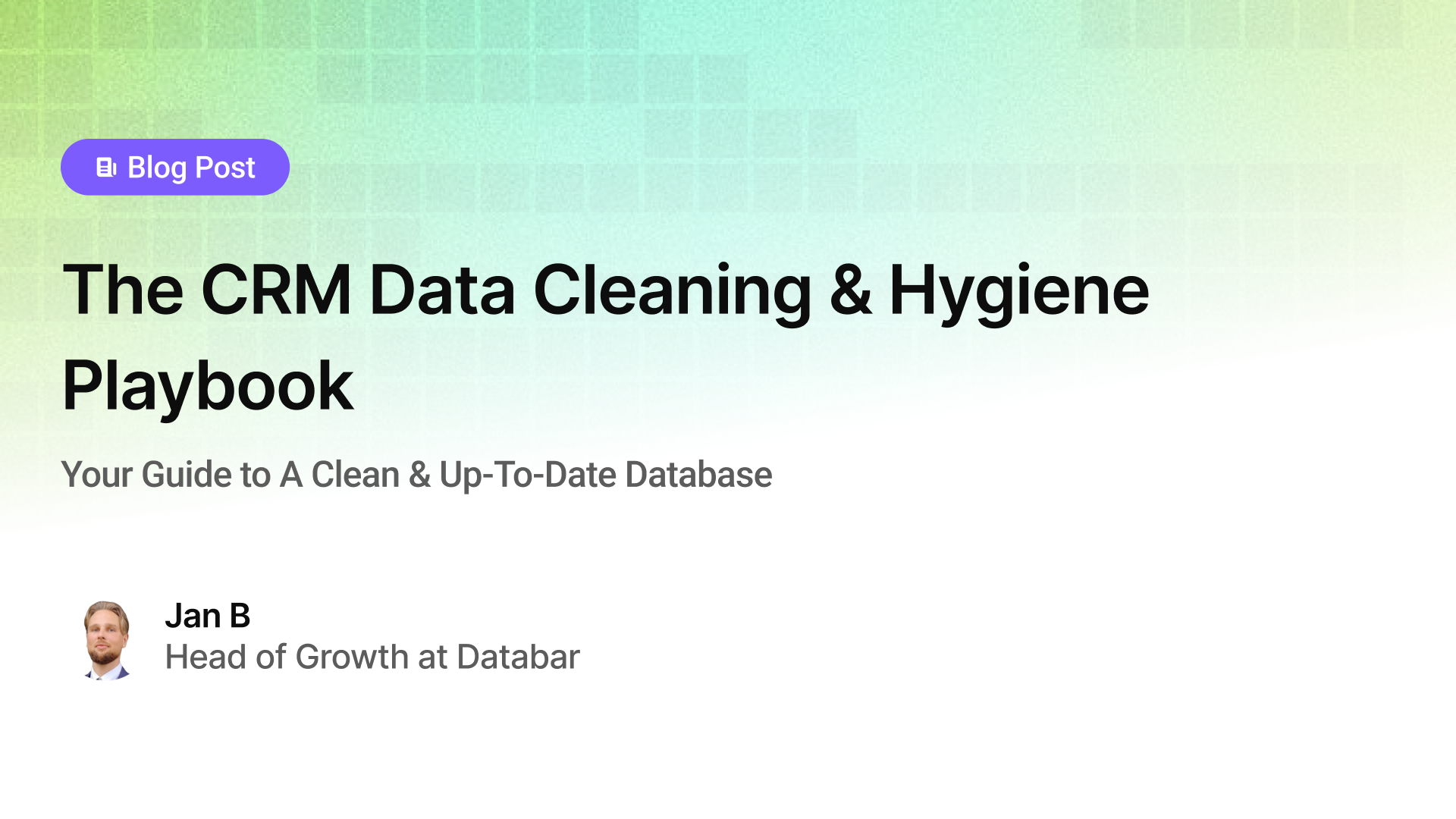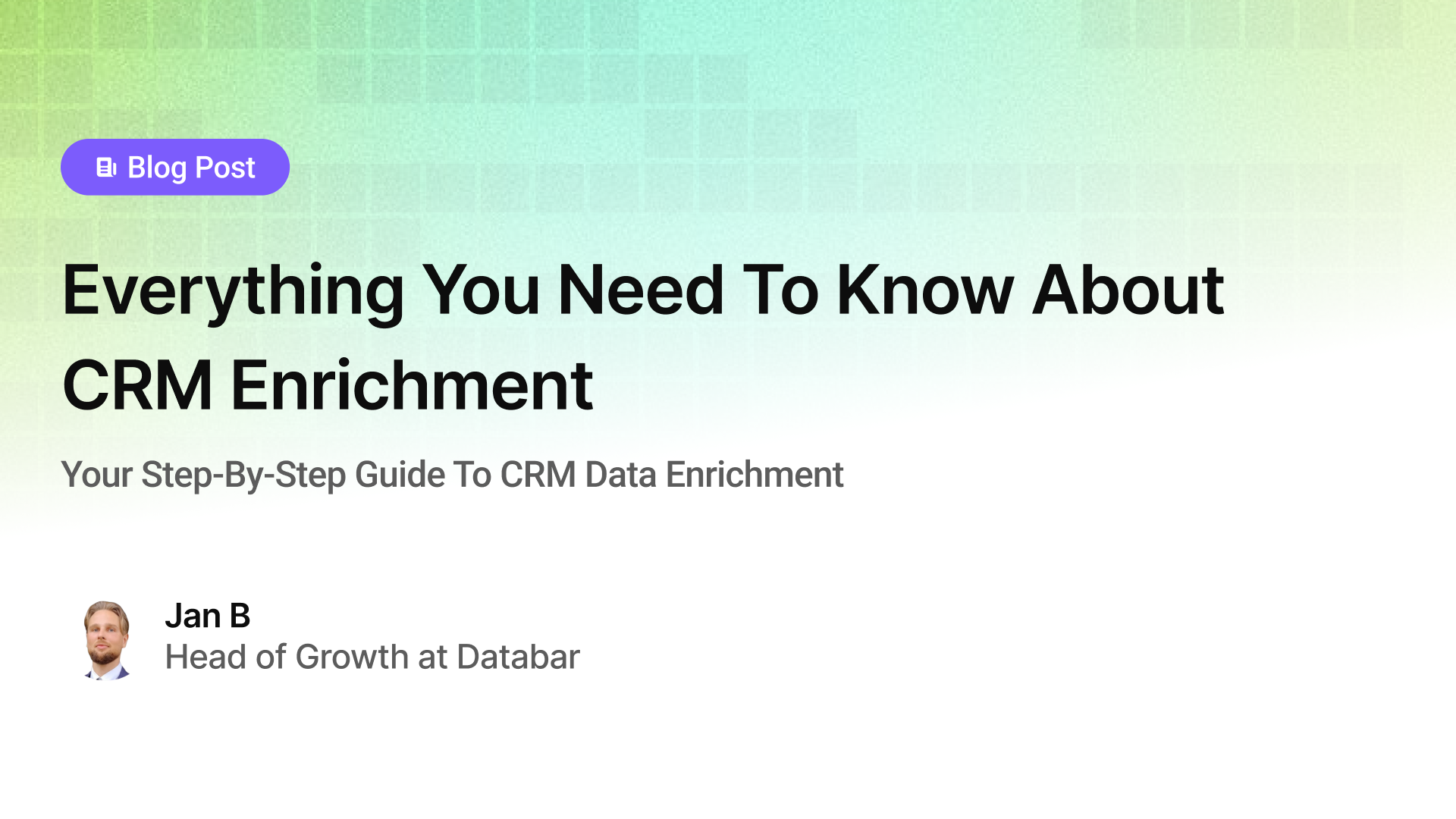From SDR to GTM Engineer: Complete Career Transition Roadmap
A Step-by-Step Guide for SDRs Ready to Become GTM Engineers
Blogby JanJuly 08, 2025

Sales development representatives often find themselves at a crossroads after grinding through traditional prospecting for years. Endless cold calls, copy-paste email templates, and watching reply rates tank every month. Does this sound familiar?
Many SDRs express a common desire: "I just want to build a system that handles all this prospecting automatically and actually gets people to respond."
This describes exactly what GTM engineers do every day.
The traditional SDR model in 2025 faces significant challenges. Companies are exploring alternatives to teams of multiple SDRs, including investing in GTM engineers who build automated systems. Response rates for traditional cold outreach continue declining, while automated, personalized systems show good engagement.
SDRs are uniquely positioned to make this career transition. You already understand the pain points, know what messages actually resonate with prospects, and have experienced firsthand what falls flat. You just need to learn how to build systems instead of grinding through manual execution.
Whether you're currently an SDR looking for a more strategic role, or you're in business development and want to move into the technical side of revenue generation, this roadmap will show you exactly how to make the transition successfully.
Why SDRs Make Perfect GTM Engineers
Most people assume GTM engineering is purely about technical skills, but that's only half the equation. The most successful GTM engineers often start in sales roles because they understand something crucial: what actually moves the needle with prospects.
You Already Get the Customer Journey
As an SDR, you've been in the trenches of prospecting daily. You know which subject lines get opens, what pain points hit home, and how to qualify leads properly. This isn't book knowledge – it's real-world experience that most technical professionals simply don't have.
GTM engineers coming from pure engineering backgrounds often build technically impressive systems that generate poor results because they miss the buyer psychology piece. SDRs who transition into GTM engineering build systems that actually convert because they know what prospects want to hear.

You Know What Breaks Down at Scale
Every SDR has felt the frustration of manual research, copy-paste personalization, and juggling multiple tools that refuse to talk to each other. This pain becomes your secret weapon as a GTM engineer because you can spot which processes desperately need automation.
You Have Real Revenue Impact Experience
Unlike traditional engineering roles that stay removed from revenue generation, SDRs understand how their work directly impacts pipeline and closed deals. This business context is crucial for GTM engineers because every technical decision needs to optimize for revenue outcomes.
Companies typically look for GTM engineers who can think strategically about business impact, not just build impressive technical solutions. Your SDR experience provides this strategic foundation that purely technical candidates often lack.
The Current Market (And Why Timing Is Perfect)
The shift from traditional SDR teams to GTM engineers represents a fundamental change in how companies approach outbound sales.
Traditional SDR Models Face Challenges
Companies are discovering that hiring more SDRs doesn't automatically solve pipeline problems. Response rates continue dropping, costs keep increasing, and SDR turnover remains high. The volume-based approach faces increasing headwinds.
Meanwhile, companies investing in GTM engineers report better results. Organizations are exploring models where fewer GTM engineers can generate equivalent or better pipeline through automated systems.
The Tools Have Finally Caught Up
What makes this transition possible now is that automation tools have evolved dramatically. Platforms like Databar and Clay, no-code automation tools, and AI-powered personalization mean you can build sophisticated GTM systems without being a software engineer.
Previously, automating complex sales workflows required months of custom development. Today, you can build similar systems in days using no-code platforms that any SDR can learn.
Companies Are Actively Looking for This Hybrid Background
Job postings for GTM engineers increasingly mention "sales experience preferred" or "understanding of B2B sales processes." Companies have learned that purely technical hires often struggle to build systems that actually drive revenue.
Your sales background combined with technical skills makes you an attractive candidate because you can bridge the gap between what's technically possible and what actually works for business development.
Skills You Already Have (That You Might Not Realize)
Before diving into what you need to learn, let's acknowledge the valuable skills you already possess as an SDR.
Process Optimization Mindset
Every successful SDR naturally develops systems for managing their pipeline, organizing prospects, and tracking activities. You might not call it "process optimization," but that's exactly what you're doing when you create email templates, build contact lists, or develop qualification frameworks.
This systematic thinking is fundamental to GTM engineering. The main difference is that instead of creating manual processes, you'll learn to automate them.
Data Analysis Skills
SDRs constantly analyze data – tracking open rates, response rates, conversion metrics, and pipeline health. You understand which metrics actually matter for revenue generation and how to optimize for them.
GTM engineers use the same analytical mindset but apply it to automated systems. Instead of manually tracking your individual performance, you'll build systems that automatically track and optimize performance across entire campaigns.
Understanding of Sales Technology
Most SDRs use multiple different tools daily: CRM platforms, email sequencing tools, LinkedIn automation, data enrichment services, and analytics dashboards. You already understand how these tools work and where they typically break down.
This technology fluency gives you a huge head start because you know which integrations actually matter and which tools solve real problems versus just creating more complexity.
Customer Communication Skills
Your ability to communicate effectively with prospects translates directly to GTM engineering success. You'll use the same skills to understand requirements from sales teams, explain technical solutions to non-technical stakeholders, and gather feedback on system performance.
Some technical people might struggle with stakeholder communication, but SDRs excel at it because effective communication with challenging audiences has been a core job requirement.

Technical Skills You Need to Learn
Now let's talk about the technical competencies you need to develop. Don't let this intimidate you – these are learnable skills, and your sales background actually makes learning them easier.
CRM Platform Mastery
You probably use Salesforce or HubSpot daily, but GTM engineers need deeper expertise. This means understanding custom objects, workflow automation, advanced reporting, and API integrations.
The good news is that you already understand how CRMs should work from a user perspective. Learning the administrative and technical side becomes much easier when you already know what outcomes you're trying to achieve.
Start with official certification programs like Salesforce Trailhead or HubSpot Academy. Focus on the automation and integration modules rather than basic user training, since you already understand the fundamentals.
Automation Platforms
Tools like N8N, Zapier, Make, and modern automation platforms have revolutionized what's possible without traditional programming. These platforms let you connect different tools, automate data flows, and build sophisticated workflows using visual interfaces.
As an SDR, you probably wish certain manual tasks could be automated – lead research, data entry, follow-up scheduling, or report generation. No-code platforms let you actually build these automations yourself.
For comprehensive data enrichment and workflow automation, platforms like Databar.ai have become particularly important in the GTM engineering world. They combine data enrichment from 90+ providers with AI-powered research and workflow automation in one platform.
Basic Programming Skills
You don't need to become a software engineer, but learning basic Python and SQL will significantly expand what you can accomplish. Python is excellent for data manipulation and building custom automations that go beyond what no-code tools can handle.
SQL is essential for extracting data from databases, creating custom reports, and analyzing large datasets. These skills let you answer complex business questions and build more sophisticated automation systems.
Start with practical, sales-focused projects rather than theoretical programming exercises. For example, learn Python by building scripts that analyze your sales data or automate prospect research.
AI Tool Integration
AI tools have become central to modern GTM strategies, and knowing how to integrate them effectively is incredibly valuable. This includes prompt engineering for generating personalized content, using AI for prospect research, and automating data analysis.
The key is understanding how to use AI tools to solve specific sales problems rather than just playing with technology. Your SDR experience helps here because you know which problems are actually worth solving.
Building Your GTM Engineer Portfolio
Here's where most people get stuck – how do you demonstrate GTM engineering skills when you're still working as an SDR? The answer is building a portfolio of projects that showcase your abilities.

Based on feedback from GTM engineers, communities and actual job requirements, here are specific projects that will impress potential employers:
Automated Lead Scoring System: Build a workflow that enriches leads from multiple data sources and automatically scores them based on your ideal customer profile. Show how this improves lead quality and saves research time.
Personalized Outreach Automation: Create a system that researches prospects using AI, generates personalized email content, and automatically sequences outreach based on engagement patterns. Document the improvement in response rates.
Sales Activity Analytics Dashboard: Build a reporting system that tracks key sales metrics across multiple platforms and provides actionable insights for sales teams. Show how this impacts decision-making.
Intent-Based Prospecting Workflow: Create an automation that monitors buying signals (job changes, funding events, technology adoption) and automatically triggers personalized outreach campaigns.
CRM Enrichment System: Build a workflow that automatically enriches contact and company records in your CRM using multiple data sources, ensuring sales teams always have current information.
How to Build Portfolio Projects
Start with problems you've experienced personally as an SDR. What manual tasks eat up your time? What data do you wish you had access to? What processes break down regularly?
Use your current role as a testing ground. Build small automations that improve your own productivity, then document the results. Even if you can't share specific data, you can show the methodology and explain the impact.
Focus on business outcomes, not just technical features. Employers want to see that your solutions actually improve revenue generation, reduce costs, or save time. Quantify the impact whenever possible.
Documenting Your Work
Create a simple website or GitHub repository that showcases your projects. For each project, include:
- The business problem you were solving
- The technical approach you used
- The tools and platforms involved
- The measurable impact or results
- Screenshots or demos of the solution
Write up your projects like case studies rather than technical documentation. Remember, many people evaluating your portfolio will be from business backgrounds, not technical ones.
The Transition Timeline
Most successful SDR-to-GTM engineer transitions take 6-12 months of focused learning and skill development. Here's a realistic timeline:
1. Foundation Building
Start with CRM certification and basic automation tools. Take the Salesforce Administrator certification or HubSpot Marketing Software certification. Learn Zapier basics and build 2-3 simple automations.
Begin learning modern data enrichment platforms through their documentation and capabilities. Start with simple data enrichment workflows and gradually build more complex automation systems.
2. Technical Skill Development
Learn basic Python and SQL through sales-focused tutorials and projects. Focus on practical applications like analyzing sales data or automating prospect research.
Build your first major portfolio project – something that solves a real problem you've experienced as an SDR. Document the entire process and results.
3. Advanced Automation
Learn more sophisticated automation concepts like conditional logic, error handling, and system integrations. Build workflows that connect multiple platforms and handle complex business logic.
Complete 2-3 additional portfolio projects that demonstrate different aspects of GTM engineering – lead scoring, personalization, analytics, etc.
4. AI Integration and Specialization
Learn AI tool integration, prompt engineering, and data analysis. Build systems that use AI for prospect research, content generation, or predictive analytics.
Start specializing in specific areas that interest you – whether that's data engineering, AI automation, or platform integrations.
5. Job Search and Portfolio Refinement
Polish your portfolio, update your LinkedIn profile, and start networking with GTM engineers and potential employers. Apply for junior GTM engineer positions or internal transitions.
Continue building and refining projects based on feedback from interviews and industry connections.
Overcoming Common Transition Challenges
Every SDR making this transition faces similar obstacles. Here's how to address the most common ones:
"I'm Not Technical Enough"
This is the biggest mental barrier, but it's largely unfounded. Many successful GTM engineers started with a basic technical background. The key is starting with no-code tools that don't require programming knowledge.
Focus on solving business problems rather than learning technology for its own sake. Your sales background actually makes you better at identifying which technical solutions will drive real business value.
"I Don't Have Time to Learn While Working Full-Time"
Start with small improvements to your current role. Build automations that make your SDR work more efficient, then document and expand on them. This approach helps you learn while improving your current performance.
Dedicate 30-60 minutes daily to learning. This is enough to make significant progress over several months without burning out or affecting your sales performance.
"Companies Won't Take Me Seriously Without a Technical Degree"
The GTM engineering field values practical skills and business impact over formal credentials. A portfolio of working solutions that solve real problems is more impressive than a computer science degree.
Many companies specifically prefer candidates with sales backgrounds because they understand the business context that technical solutions need to address.
"I Don't Know Where to Start"
Begin with the tools you already use. If you use Salesforce, learn more advanced Salesforce automation. If you use email sequencing tools, learn how to integrate them with other platforms.
Join GTM engineering communities (like our Databar Discord channel) and follow practitioners who share their work publicly. This gives you ideas for projects and helps you understand what skills are most valuable.
Landing Your First GTM Engineer Role
The job search process for GTM engineers is different from traditional sales or technical roles. Here's how to approach it effectively:
Where to Look for Opportunities
Many GTM engineer roles are posted under different titles: Sales Operations Engineer, Revenue Operations Specialist, Growth Engineer, or Marketing Automation Manager. Expand your search beyond just "GTM Engineer."
Target companies that are scaling rapidly and dealing with GTM complexity. These organizations are most likely to value the hybrid skills that former SDRs bring to technical roles.
Consider internal transitions first. If your current company is growing, they might be open to creating a GTM engineer role or transitioning you into sales operations with technical responsibilities.
Positioning Your Background
Lead with your business impact, not your technical skills. Emphasize how your sales experience helps you build systems that actually drive revenue rather than just impressive technical solutions.
Highlight specific problems you've solved or inefficiencies you've identified. Companies want GTM engineers who can spot opportunities for improvement and implement solutions that work.
Use your portfolio to demonstrate technical competence, but frame everything in terms of business outcomes. Show how your automations improved conversion rates, saved time, or increased pipeline quality.
Interview Preparation
Prepare to discuss both technical implementation details and business strategy. You might be asked to explain how you'd approach building a lead scoring system or automating a complex sales workflow.
Practice explaining technical concepts to non-technical audiences. Many GTM engineers work with sales teams, marketing teams, and executives who need to understand what you're building and why it matters.
Be ready to demonstrate your problem-solving process. Walk through how you identify opportunities, evaluate solutions, and measure success. This systematic approach is what companies value most.
Resources for Making the Transition
Here are the specific resources that will accelerate your transition from SDR to GTM engineer:
Learning Platforms
Salesforce Trailhead for CRM automation and advanced configuration. Focus on the Platform App Builder and Administrator tracks rather than basic user training.
HubSpot Academy for marketing automation and integration concepts. Their Operations Hub certification is particularly relevant for GTM engineers.
Modern data enrichment platforms provide comprehensive resources for building real-world GTM workflows and understanding advanced automation capabilities.
Communities and Networking
GTM Engineering communities where practitioners share projects, ask questions, and discuss emerging trends. These groups are invaluable for staying current and finding opportunities.
Revenue Operations communities that focus on the business side of GTM strategy. Understanding revenue operations concepts is crucial for GTM engineer success.
Local sales and marketing meetups where you can network with potential employers and learn about companies that might need GTM engineering capabilities.
Project-Based Learning
Start with platform template libraries to see examples of working GTM systems. Reverse-engineer these workflows to understand how they work, then modify them for your own use cases.
Build automations for your current role that solve real problems. Document these projects thoroughly to demonstrate your capabilities to potential employers.
Understanding how different tools integrate becomes crucial. For comprehensive guidance, explore our analysis of CRM enrichment tools that work well with automation platforms.
Contribute to open-source projects or build public tools that solve common GTM problems. This demonstrates your technical skills while building your professional reputation.
For teams looking to understand the broader landscape, our guide to prospecting tools for small teams provides context on how GTM engineering fits into modern sales technology stacks.
The Bottom Line
The transition from SDR to GTM engineer represents one of the most promising career pivots in modern sales and marketing. You already have the business foundation that many technical people lack, and the technical skills are learnable with focused effort.
Companies actively seek professionals who can bridge the gap between sales strategy and technical implementation. Your SDR experience positions you perfectly to build systems that not only work technically but actually drive revenue growth.
The key is starting with practical projects that solve real problems, building your technical skills incrementally, and documenting your progress thoroughly. Within 6-12 months of focused learning, you can position yourself for GTM engineer roles that offer better compensation, more strategic impact, and significantly more career growth potential than traditional SDR positions.
Building effective cold email tech stacks and understanding how different automation tools work together becomes an essential skill for GTM engineers transitioning from sales roles.
Frequently Asked Questions
How long does it typically take to transition from SDR to GTM Engineer?
Most successful transitions take 6-12 months of focused learning and skill development. This includes building technical skills, creating portfolio projects, and networking within the GTM engineering community. The timeline depends on how much time you can dedicate to learning while maintaining your current role.
Do I need to learn programming to become a GTM Engineer?
Basic programming skills (Python and SQL) are highly valuable and will significantly expand your opportunities, but you can start with no-code tools like modern automation platforms, Zapier, and CRM automation. Many entry-level GTM engineer roles focus more on no-code solutions and business process optimization.
What's the salary difference between SDR and GTM Engineer roles?
GTM engineers typically earn significantly more than SDRs due to the technical skills premium and the direct revenue impact of the role. The increase comes from combining technical capabilities with business impact. Senior GTM engineers at growing companies often earn more than senior sales representatives.
Will my SDR experience actually help, or do I need to start over?
Your SDR experience is incredibly valuable – it's actually your biggest competitive advantage. You understand customer pain points, sales processes, and what actually drives revenue. Many technical people struggle in GTM engineering roles because they lack this business context.
What companies are most likely to hire former SDRs as GTM Engineers?
High-growth B2B SaaS companies that are scaling their GTM operations, companies that use modern sales tech stacks, and organizations that value business context over pure technical credentials. Many companies specifically prefer candidates with sales backgrounds for GTM engineering roles.
What should I include in my GTM engineering portfolio?
Focus on projects that solve real business problems: automated lead scoring systems, personalized outreach workflows, CRM enrichment processes, and analytics dashboards. Document the business impact of each project, not just the technical implementation. Show how your solutions improve revenue outcomes or operational efficiency.
Related articles

Buying Signals & Intent Data: Why Your CRM Is Missing the 5 Accounts
Why Most Teams Miss Their Hottest Prospects (And How to Fix Your Signal Detection)
by Jan, October 06, 2025

Lead Scoring & Account Segmentation: Why Most CRMs Get This Backward (And How to Fix It)
How to build a system that tells your team who to call, when, and why
by Jan, October 06, 2025

The CRM Data Cleaning & Hygiene Playbook
Your Guide to A Clean & Up-To-Date Database
by Jan, October 04, 2025

Everything You Need To Know About CRM Enrichment
Your Step-By-Step Guide To CRM Data Enrichment
by Jan, October 03, 2025

